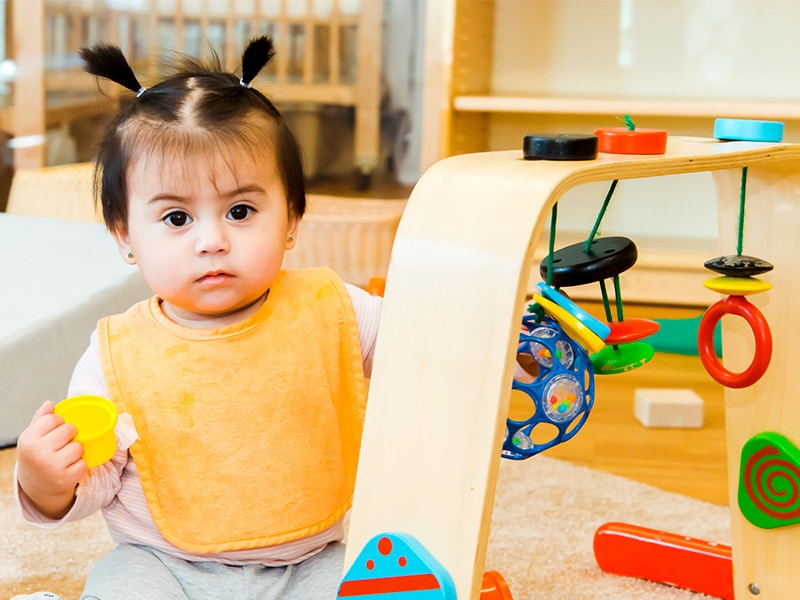
Notes From Olympia: Feb. 23, Week 7 of the 2024 Legislative Session
This edition includes caseload forecasts, budgets, more cutoffs, voter initiatives and … shellfish.
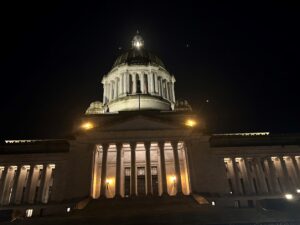 The Legislative Building awaits another busy week
The Legislative Building awaits another busy week
(Photo Credit: Erica Hallock)
Trivia!
The Humble Bivalve. HB 1984 by Representative Mike Chapman would designate which clam as the official clam of Washington state?
Spoiler alert: This bill was pre-filed before the legislative session, but it didn’t make it out of committee. Perhaps it will “mussel” its way through the Legislature in another year.
Highlights of the Week
Potato Day! The potatoes this year really hit the spot, and you can tell the people on campus love these sponsored food days. Thank you to the Washington State Potato Commission!
 Potato Day!
Potato Day!
(Photo Credit: Zoë Erb)
Caseload Forecast
On Friday, Feb. 16, the Washington State Caseload Forecast Council released its updated caseload forecast. These caseload forecasts project expected caseloads for entitlement programs ranging from K-12 education to public assistance to corrections. Budget writers use this data to inform their budgets.
In terms of early learning, the following are updated forecasted caseloads:
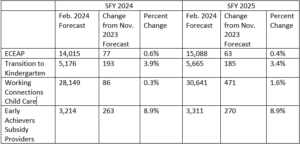
Narratives accompanying the caseload forecasts and analyses of note (including any risks to the forecasts) are as follows:
- Transition to Kindergarten (TTK). TTK has been more popular in smaller school districts and rural communities, and less common in certain areas such as King County. Risks to the forecast include variance depending upon the month in which a school district starts its TTK program. The narrative also notes TTK is a newer program, which makes forecasting future caseloads more challenging.
- ECEAP. The narrative notes that nearly all of the enrollment growth for ECEAP in the 2022-23 school year was from children who were not “entitlement eligible” (meaning children who meet eligibility to participate under rules adopted by DCYF, not those eligible by income). The forecast also finds enrollment has been higher in the 2023-24 school year than in the 2022-23 year.
- Working Connections Child Care. The forecast accounts for recently enacted legislation that builds on the Fair Start for Kids Act and further expands eligibility for Working Connections Child Care. There is also assumed continued recovery from the pandemic in terms of child care usage.
- Early Achievers Subsidy Providers. The forecasted growth in Early Achievers Subsidy Providers should have an asterisk next to it because it represents the use of a new system to track number of providers. With this new system, we should have a more accurate count of the number of licensed providers participating in Early Achievers going forward. One particular item of note is the assumption that the increased enrollment of new providers is being driven by recent increases in reimbursement rates, particularly those for family child care providers.
Supplemental Budget Updates. Earlier this week, the Senate and House released their Operating and Capital budgets (as well as Transportation budgets). The released documents reflect more of a traditional supplemental budget approach, with the limited new investments focused on high priority, time sensitive items such as fentanyl response, housing and the overall workforce crisis.
Start Early Washington shared a side-by-side comparison of the various – and varying – approaches to the Operating and Capital budgets proposed by the Senate, House, and the Governor that impact early learning, on our state policy resources page. The side-by-side comparison chart highlights how the bodies invested quite differently in early learning. With just 13 days left in the official legislative session, the clock is ticking for the two bodies to come to an agreement on their differences and settle on final budgets that will garner sufficient votes for passage.
We will continue to update the budget summary comparison chart as the process continues. We expect the Senate and House to pass their respective Operating budgets over the coming weekend.
One important tip to remember: it is protocol for the initially released budgets to include funding for bills passed out of the House of Origin. Typically, funding for a House bill would be included in the House budget, but not in the Senate budget, and visa versa. There are pros and cons to this approach in that each body’s budget holds “space” for funding of bills, but it also means – particularly in tighter fiscal years – there will likely need to be cuts during the negotiations to accommodate the funding of all of the bills that will make their way through the process.
Bills, Bills, Bills! Weds, Feb. 21 represented the final policy committee cutoff. Most early learning-related bills were heard – and approved – by the policy committee cutoff deadline. Start Early Washington updated its bill tracker on our state policy resources page to reflect the latest versions.
Continuing the theme of “no rest until interim” (sung to the tune of “no sleep till Brooklyn”), Thursday morning saw the start (again!) of marathon fiscal committee hearings in advance of the Feb. 26 opposite chamber fiscal committee cutoff. (Yet another weekend of work. Oh, joy.) And then it’s back to the floor where the bodies will consider bills from the opposite chamber. PHEW!
What’s on Deck for Next Week?
Hearings on Three Initiatives
This week, Democratic leadership announced public hearings on three of the six certified Initiatives to the Legislature Feb. 27-28, with the remaining three initiatives destined for voter determination in the November general election.
Scheduled public hearings include:
- Initiative 2111 relating to limiting the ability of state and local governments to impose an income tax, will be heard in a Joint Hearing by the Senate Ways and Means and the House Finance Committees Feb. 27 at 12:30 p.m.
- Initiative 2081 concerning parental rights and their children’s public school education, will be heard in a Joint Hearing by the Senate Early Learning and K-12 and the House Education Committees Feb. 28 at 8 a.m.
- Initiative 2113 relating to vehicular pursuits by police officers, will be heard in a Joint Hearing by the Senate Law and Justice and the House Community Safety, Justice, & Reentry Committee Feb. 28 at 9 a.m.
Speculation around the Capitol campus is that following these public hearings, the Senate and House will vote to accept these three Initiatives to the Legislature, so they will not go before the voters.
There is question about how consideration of these initiatives will factor into the typical end-of-session busyness involving budget resolution, final passage of bills and concurrence in amendments made in the opposite chamber. One thing can be said about Olympia – it is never boring!
The remaining three initiatives still slated to head to the November ballot are:
- Initiative 2109 – Repeal of the Capital Gains Tax
- Initiative 2117 – Repeal of the Climate Commitment Act
- Initiative 2124 – Repeal of the Long-Term Care Tax
The Feb. 16 edition of the Washington State Standard has a great piece by Jerry Cornfield covering the ins and outs of this issue. And refer to our Jan. 19 edition of Notes From Olympia for more information on the six initiatives and the initiative process.
Trivia Answer
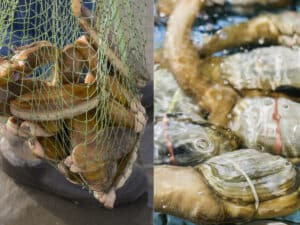
A side-by-side of the razor clam and the geoduck
(Photo Credit: iStock.com via The Columbian)
Had Representative Chapman’s HB 1984 passed, the Pacific razor clam, aka the Siliqua patula, would have become the official state clam.
HB 1984 includes the statistic that people in Washington have harvested over 8 million clams annually in recent years, and that clam digging is an important activity—not just in terms of fun, but also as a source of food and cultural significance.
According to the Department of Fish & Wildlife, the Pacific razor clam is one of the “most sought after shellfish” in the state. The Department even developed this handy-dandy guide for clam digging. If you decide to try your hand at clam digging, be sure to check for any current razor clam season information, as well as the rules and regulations for sport fishing.
If this bill seems familiar, it’s because we’ve seen it before, but in a different form. Former Representative Brian Blake and current Representative Jim Walsh sponsored HB 1061 which was heard in both 2019 and 2020, but it didn’t quite make it to the finish line.
The Seattle Times credits the original effort to designate a state clam to David Berger, who wrote “Razor Clams: Buried Treasure of the Pacific Northwest” and lobbied lawmakers for the designation. The Times also informed its readers that Berger was so passionate about this issue that he contacted Kelli Hughes-Ham, a sixth grade teacher at Hilltop Middle School in Ilwaco, Pacific County. She used the bill as an opportunity to teach her students about the legislative process, and her class made posters to encourage lawmakers to designate the razor clam as the official state clam. This is not unlike the efforts of Amy Cole’s former fourth grade class to make the Suciasaurus Rex the official state dinosaur, which Governor Inslee finally signed into law after a multi-year effort in 2023.
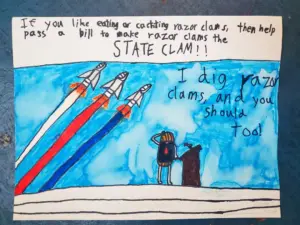 One of the sixth grade lobbyist posters in support of the Pacific razor clam
One of the sixth grade lobbyist posters in support of the Pacific razor clam
(Photo Credit: Kelli Hughes-Ham, courtesy of the Seattle Times)
Perhaps one of the reasons these bills haven’t made it to the governor’s desk is because this has become a hot topic at the Legislature—a battle of the bivalve mollusks if you will. Governor Inslee even referenced this heated debate at an event this week, saying that the Legislature shouldn’t rest until we have an official state clam!
While the Pacific razor clam has supporters, the geoduck is still a formidable opponent. Members of the House’s State Government and Tribal Relations Committee wanted to be sure to give proponents of the geoduck an opportunity to have their say as well. Both geoducks and clams are members of the bivalve mollusk family. For those of you who may need to Google it (I know I did), bivalve mollusks “have an external covering that is a two-part hinged shell that contains a soft-bodied invertebrate” according to the National Ocean Service. In this instance, an invertebrate is simply an animal that does not have a backbone. (This is just begging for a joke about politicians and backbones.)
Although the geoduck is already the school mascot of the Evergreen State College, we can see the argument for designating it as the state clam as well. Geoduck aquaculture is alive and well, frequenting approximately 200 square acres of tidelands in our state. Much of that tideland is privately owned, but the Department of Natural Resources (DNR) has explored whether publicly owned state-lands could host geoduck farms. Washingtonians are not the only geoduck fans; they are a delicacy in Asia and can fetch a rate of up to $125 per pound. DNR reported in 2020 that the state exports around 11 million pounds each year. Clearly it plays a huge role in the state economy, and it is also allegedly the biggest shellfish found on Washington beaches.
What do you think our official state clam should be? If you have strong feelings, please let your lawmakers know (and us at Start Early WA – we’re quite curious)!
Resources:
Geoduck Aquaculture [Department of Natural Resources]
Razor clams, geoducks battle to be WA’s top clam [The Columbian]
Razor clams, geoducks battle to be WA’s top clam [The Seattle Times]
Razor clam seasons and beaches [Department of Fish & Wildlife]
Suciasaurus rex becomes official Washington state dinosaur after Gov. Inslee signs bill [NBC Right Now]
About the Author

Erica Hallock
Director, Policy & Advocacy, Start Early Washington
Erica Hallock serves as the Director of Policy and Advocacy for Start Early Washington. She has worked in early childhood, health and human services policy in both California and Washington state.
More About Erica